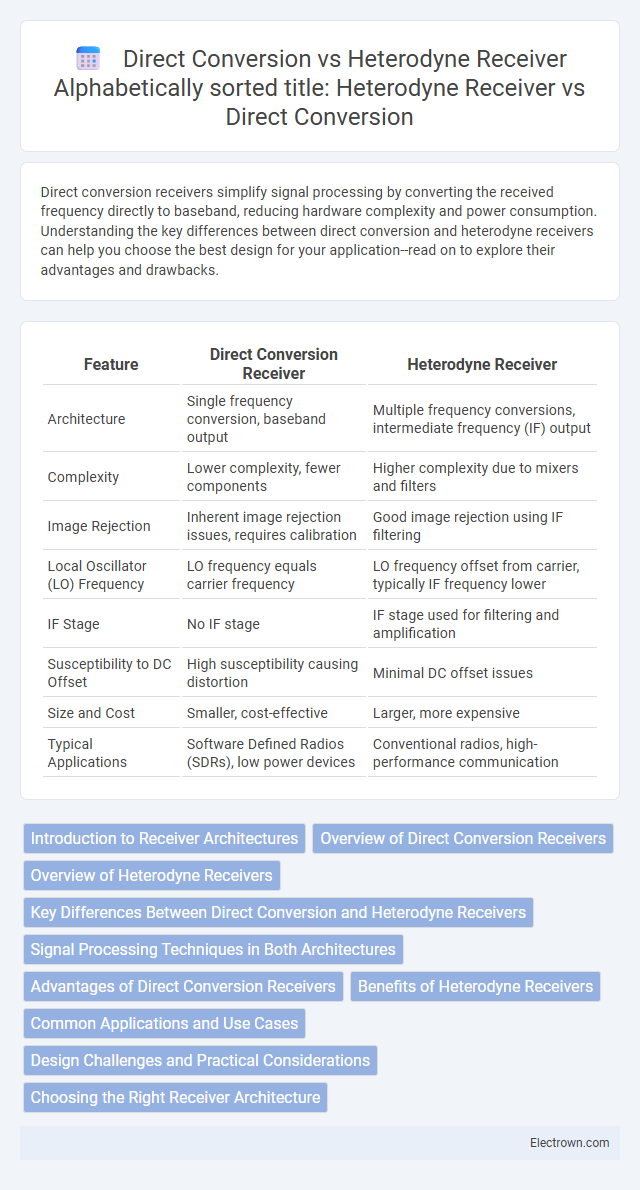Direct conversion receivers simplify signal processing by converting the received frequency directly to baseband, reducing hardware complexity and power consumption. Understanding the key differences between direct conversion and heterodyne receivers can help you choose the best design for your application--read on to explore their advantages and drawbacks.
Table of Comparison
| Feature | Direct Conversion Receiver | Heterodyne Receiver |
|---|---|---|
| Architecture | Single frequency conversion, baseband output | Multiple frequency conversions, intermediate frequency (IF) output |
| Complexity | Lower complexity, fewer components | Higher complexity due to mixers and filters |
| Image Rejection | Inherent image rejection issues, requires calibration | Good image rejection using IF filtering |
| Local Oscillator (LO) Frequency | LO frequency equals carrier frequency | LO frequency offset from carrier, typically IF frequency lower |
| IF Stage | No IF stage | IF stage used for filtering and amplification |
| Susceptibility to DC Offset | High susceptibility causing distortion | Minimal DC offset issues |
| Size and Cost | Smaller, cost-effective | Larger, more expensive |
| Typical Applications | Software Defined Radios (SDRs), low power devices | Conventional radios, high-performance communication |
Introduction to Receiver Architectures
Direct conversion receivers translate the radio frequency signal directly to baseband, simplifying the architecture by eliminating intermediate frequency stages and enabling more compact, power-efficient designs. Heterodyne receivers use one or more frequency conversion stages, mixing the incoming signal with local oscillator frequencies to an intermediate frequency before demodulation, offering superior selectivity and sensitivity. Your choice between these architectures depends on factors like complexity, performance requirements, and application-specific constraints.
Overview of Direct Conversion Receivers
Direct conversion receivers, also known as zero-IF receivers, convert the received radio frequency signal directly to baseband in one step, eliminating the need for intermediate frequency stages. This architecture simplifies the design and reduces component count, power consumption, and signal processing complexity. However, direct conversion receivers face challenges such as DC offset, flicker noise, and image rejection, requiring careful circuit design and calibration.
Overview of Heterodyne Receivers
Heterodyne receivers operate by mixing the incoming radio frequency (RF) signal with a locally generated oscillator frequency to produce an intermediate frequency (IF) signal, which allows for easier and more selective signal processing. This architecture enhances sensitivity and selectivity by enabling narrowband filtering and amplification at a fixed IF, reducing distortion and improving signal-to-noise ratio. Widely used in advanced communication systems, heterodyne receivers support complex modulation schemes and high-frequency operation, making them ideal for applications requiring precise frequency control and stability.
Key Differences Between Direct Conversion and Heterodyne Receivers
Direct conversion receivers translate the radio frequency (RF) signal directly to baseband without intermediate frequency (IF) processing, minimizing component count and enabling simpler circuit design. Heterodyne receivers use a fixed or variable local oscillator to convert RF signals to an IF, providing enhanced selectivity and sensitivity through filtering at the IF stage. Key differences include complexity, with direct conversion offering simplicity and lower cost, while heterodyne offers superior performance in terms of image rejection and dynamic range.
Signal Processing Techniques in Both Architectures
Direct conversion receivers utilize zero-IF architecture by converting the received RF signal directly to baseband using a single mixer, simplifying signal processing through fewer stages and reduced filtering requirements. Heterodyne receivers employ an intermediate frequency (IF) conversion, mixing the RF signal with a local oscillator to produce an IF signal that allows for selective filtering and amplification, enhancing sensitivity and image rejection. The signal processing in heterodyne architectures is more complex due to multiple frequency downconversions and filtering steps, whereas direct conversion receivers benefit from simpler baseband digital signal processing (DSP) techniques.
Advantages of Direct Conversion Receivers
Direct conversion receivers offer significant advantages such as simplified architecture with fewer components, resulting in lower power consumption and reduced manufacturing costs. They provide improved integration potential and lower image frequency interference compared to heterodyne receivers, enhancing signal quality and reliability. Your communication system benefits from faster signal processing and easier adaptation to modern digital signal processing techniques.
Benefits of Heterodyne Receivers
Heterodyne receivers offer superior sensitivity and selectivity by converting the received signal to an intermediate frequency (IF), which allows for effective filtering and amplification, minimizing noise and interference. Their ability to handle strong signals without distortion and provide stable frequency conversion results in better performance in complex communication environments. This architecture is widely favored in applications requiring precise tuning and robust signal processing, including radio broadcasting and radar systems.
Common Applications and Use Cases
Direct conversion receivers are widely used in modern wireless communication devices such as smartphones, Bluetooth headsets, and software-defined radios due to their simple architecture and low power consumption. Heterodyne receivers remain prevalent in applications requiring high sensitivity and selectivity like radar systems, satellite communications, and traditional television tuners. The choice between the two often depends on factors such as frequency stability, image rejection, and overall complexity needed for specific use cases.
Design Challenges and Practical Considerations
Direct conversion receivers face design challenges such as DC offset, LO leakage, and flicker noise, which complicate accurate signal demodulation. Heterodyne receivers require multiple frequency conversions and complex filtering to manage image frequency rejection and phase noise, increasing circuit complexity and power consumption. Practical considerations include the simpler architecture and lower cost of direct conversion for low-frequency applications, while heterodyne architectures excel in selectivity and sensitivity for high-frequency, high-performance systems.
Choosing the Right Receiver Architecture
Selecting the appropriate receiver architecture depends on factors like complexity, frequency accuracy, and application requirements. Direct conversion receivers offer simpler design and lower power consumption, ideal for compact, low-cost devices, while heterodyne receivers provide superior selectivity and better image rejection, preferred in high-performance communication systems. Evaluating trade-offs in noise figure, linearity, and integration capabilities ensures optimal performance for specific RF environments.
Direct Conversion vs Heterodyne Receiver Infographic

 electrown.com
electrown.com